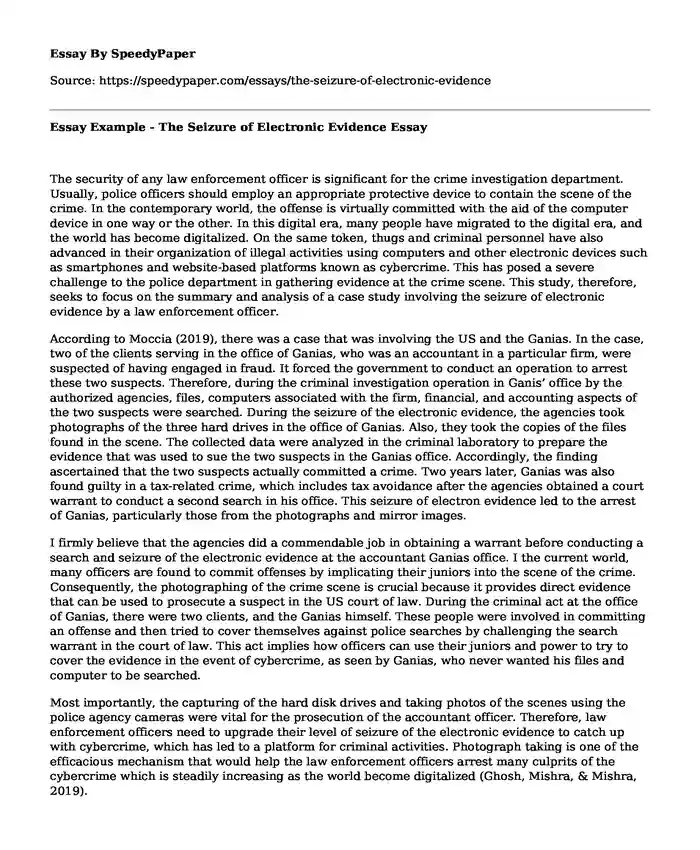
| Type of paper: | Essay |
| Categories: | Criminal law Police Cyber security Essays by wordcount |
| Pages: | 3 |
| Wordcount: | 654 words |
The security of any law enforcement officer is significant for the crime investigation department. Usually, police officers should employ an appropriate protective device to contain the scene of the crime. In the contemporary world, the offense is virtually committed with the aid of the computer device in one way or the other. In this digital era, many people have migrated to the digital era, and the world has become digitalized. On the same token, thugs and criminal personnel have also advanced in their organization of illegal activities using computers and other electronic devices such as smartphones and website-based platforms known as cybercrime. This has posed a severe challenge to the police department in gathering evidence at the crime scene. This study, therefore, seeks to focus on the summary and analysis of a case study involving the seizure of electronic evidence by a law enforcement officer.
According to Moccia (2019), there was a case that was involving the US and the Ganias. In the case, two of the clients serving in the office of Ganias, who was an accountant in a particular firm, were suspected of having engaged in fraud. It forced the government to conduct an operation to arrest these two suspects. Therefore, during the criminal investigation operation in Ganis’ office by the authorized agencies, files, computers associated with the firm, financial, and accounting aspects of the two suspects were searched. During the seizure of the electronic evidence, the agencies took photographs of the three hard drives in the office of Ganias. Also, they took the copies of the files found in the scene. The collected data were analyzed in the criminal laboratory to prepare the evidence that was used to sue the two suspects in the Ganias office. Accordingly, the finding ascertained that the two suspects actually committed a crime. Two years later, Ganias was also found guilty in a tax-related crime, which includes tax avoidance after the agencies obtained a court warrant to conduct a second search in his office. This seizure of electron evidence led to the arrest of Ganias, particularly those from the photographs and mirror images.
I firmly believe that the agencies did a commendable job in obtaining a warrant before conducting a search and seizure of the electronic evidence at the accountant Ganias office. I the current world, many officers are found to commit offenses by implicating their juniors into the scene of the crime. Consequently, the photographing of the crime scene is crucial because it provides direct evidence that can be used to prosecute a suspect in the US court of law. During the criminal act at the office of Ganias, there were two clients, and the Ganias himself. These people were involved in committing an offense and then tried to cover themselves against police searches by challenging the search warrant in the court of law. This act implies how officers can use their juniors and power to try to cover the evidence in the event of cybercrime, as seen by Ganias, who never wanted his files and computer to be searched.
Most importantly, the capturing of the hard disk drives and taking photos of the scenes using the police agency cameras were vital for the prosecution of the accountant officer. Therefore, law enforcement officers need to upgrade their level of seizure of the electronic evidence to catch up with cybercrime, which has led to a platform for criminal activities. Photograph taking is one of the efficacious mechanism that would help the law enforcement officers arrest many culprits of the cybercrime which is steadily increasing as the world become digitalized (Ghosh, Mishra, & Mishra, 2019).
References
Moccia, S. (2019). Bits, Bytes, and Constitutional Rights: Navigating Digital Data and the Fourth Amendment. Fordham Urb. LJ, 46, 162.
Ghosh, S., Mishra, A., & Mishra, B. K. (2019). CyberSecurity Techniques in Distributed Systems, SLAs, and other Cyber Regulations. Cyber Security in Parallel and Distributed Computing: Concepts, Techniques, Applications, and Case Studies, 109-127.
Cite this page
Essay Example - The Seizure of Electronic Evidence. (2023, Aug 24). Retrieved from https://speedypaper.net/essays/the-seizure-of-electronic-evidence
Request Removal
If you are the original author of this essay and no longer wish to have it published on the SpeedyPaper website, please click below to request its removal:
- New York University Steinhardt Admission Essay Sample
- Essay Sample: Queen Elizabeth II's Impact on Society
- Free Essay. Fiscal Divergence or Convergence in Asian Countries: A Panel Approach
- The Health Policy Focus, Free Essay from Our Database
- Free Essay Sample. Work-Life Balance
- Essay Sample on Youssef Chahine: A Literature Review of the Iconic Film Director
- Essay Example: Authorized Access to Under the "Security Testing" Exception to Copyright Law
Popular categories




